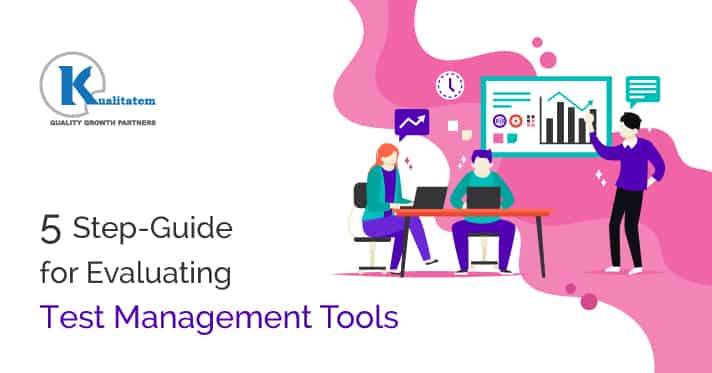5 Step Guide for Evaluating Test Management Tools

- November 2, 2018
- Kualitatem
Test management tools are used to streamline the testing procedure. These tools make the following tasks simple for the test team.
- Risk identification
- Work scheduling
- Test prioritizing
- Reporting progress
Different projects require different tools. Therefore, we are presenting you five steps to evaluate test management tools.
1. Problem Identification
It is very important for you to identify the problem you want to solve. For this, you must think about the three points mentioned below:
- Performance of the current tool.
- Needs the tools must fulfill to solve the issue
- Advantages of the new tool you would want to have
Various types of tools are involved in the test management process. A few good examples are requirements management tools, defect tracking tools, and configuration management tools, etc. Each tool requires a separate evaluation process. Therefore, capturing requirements for test management tools has become very important.
Here are some tips:
- Capture a complete view of the issue and the expected solution characteristics in one document.
- List down all the possible users and processes of assigning tests to the testers.
- Keep in mind the non-functional requirements i.e. speed of test analyst in updating a test case.
- You must include all the interested parties in the requirements capture stage. The project management and development teams are interested to know the results of the test management process.
- Requirements change with the passage of time. After completing the initial capture, go back and reexamine each requirement to check its validity.
After identifying the problem, you may decide that this problem can be solved with the help of an existing tool. On the contrary, if you are unhappy with the existing tools then follow the steps mentioned below.
2. See If Your Team Is Ready To Take On The Change
Prior to selecting and implementing a new tool, see if your team is ready to accept the change. There is no point of implementing a new tool if your team members are not agreeing to it.
Here are some tips to see if your team is willing to accept the change.
- The team that is established for a long time are generally perceived to be taking more time to get convinced for implementing a new tool.
- New people in your team are always willing to explore new tool. Therefore, a good time to implement a new tool is during the hiring phase of team members.
- If your team members are excited about implementing a new tool then it is the best time to bring this change.
3. Make A List of Potential Tools
In order to list potential tools, you first need to be clear about the requirements the tool needs to meet. Having identified these requirements in our first “Identify the Problem” step it is now advisable to split these requirements into categories like “essential”, “important”, “nice to have”, and “not required”.
After identifying the problem in the first stage, you must divide them into four categories.
- Essential
- Important
- Nice to have
- Not required
Keeping the essential requirements under consideration, it is simple to go through the entire list of a test management tool and then think upon the cost and automation that are significant to you. Therefore, you must have a quick overview of the entire list of tools and discard those which are not needed.
4. Selecting the Front Runners
Now that you have a list of preferred tools that are suitable for your project, it is the time, to begin with a detailed evaluation process. It is best for you to create an evaluation matrix. After this, you will score each tool based on your requirement and give quality score also. This will enable to select the tools that have the highest relevancy with your project.
5. Trial Phase
It is significant to test the selected tools on a mock project. Though a list of features appears to be a good fit on paper, there is nothing that beats using a tool in the practical world. If you have the time and resources then test all of the selected options.











